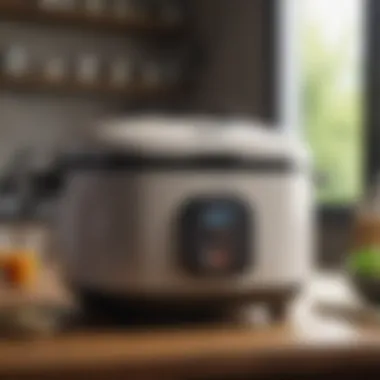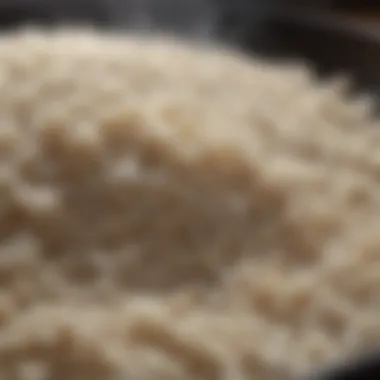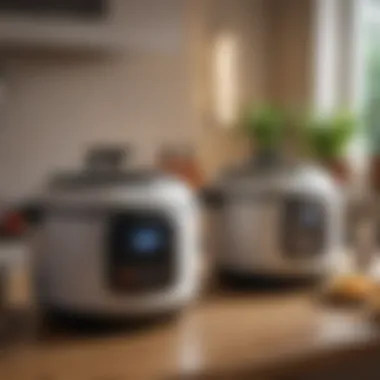Top Rice Cookers Reviewed for Every Kitchen


Intro
In today’s culinary world, where time is of the essence and convenience reigns supreme, the humble rice cooker has transformed from a mere appliance to an essential kitchen companion. This article aims to navigate the sea of rice cookers available on the market, pinning down the intricacies and features that set the best apart. From compact options ideal for small kitchens to multi-functional machines that cater to diverse cooking needs, we will break down what makes each model tick.
Imagine the aroma of perfectly cooked rice wafting through your home, elevating simple meals into delightful experiences. Whether you are a novice cook just starting your culinary journey or a seasoned chef looking for efficiency, understanding the landscape of rice cookers is crucial. This guide will walk you through performance metrics, ease of use, and maintenance tips, ensuring you can make a knowledgeable choice that aligns with your cooking style and lifestyle.
As we journey through this guide, you will find comprehensive comparisons and analyses that will empower your purchasing decisions. The world of rice cookers is expansive, and by the end, you’ll have a clear roadmap to navigating it successfully. Let’s dig in!
Intro to Rice Cooking Technology
Rice has long been a staple in many households across the globe. Yet, cooking rice to perfection requires an understanding of the essential technology involved. Rice cooking technology encompasses methods and tools that transform raw grains into the fluffy, aromatic sides we adore. In this article, we delve into not only the importance of selecting the right rice cooker but also the underlying principles of how these appliances function and what sets the best apart from the rest.
Importance of Rice Quality and Cooking Techniques
The quality of rice and the techniques used to cook it can turn an ordinary meal into an unforgettable feast. Choosing high-quality rice, whether it’s jasmine, basmati, or arborio, is crucial. This selection affects texture, flavor, and nutritional value. Consider this: good rice is like good soil for plants; it makes all the difference.
Moreover, cooking techniques play a vital role. Some cooks swear by the absorption method, while others may prefer steaming or even the instant pot method. Each technique can yield different outcomes, so understanding these methods helps one decide which type of rice cooker best suits their needs. This knowledge adds depth to one's culinary expertise and ensures a perfect grain every time.
Overview of Rice Cookers: Purpose and Functionality
Rice cookers have gained popularity not only for their ability to simplify cooking but also for their versatility in the kitchen. At their core, rice cookers are designed to automate the rice cooking process. Instead of standing over a stove watching a pot, users can set their cooker and walk away, freeing up time for other tasks. It’s like having a little kitchen assistant that takes care of the grains.
Key Functions of Rice Cookers
- Cooking Rice: This is the primary role, but many cookers excel at cooking various types of rice, such as white, brown, or sushi rice.
- Steaming Vegetables: A lot of modern rice cookers include steaming trays, allowing you to cook vegetables simultaneously.
- Slow Cooking: Some models offer extended cooking cycles, great for stews and soups.
The design and functionality of these devices vary widely. From simple, no-frills cookers to advanced units equipped with fuzzy logic technology, which adjusts cooking time and temperature for optimal texture, there's a model for every need.
Additionally, many rice cookers come with features like timers, keep-warm settings, and even programmable options that make cooking more user-friendly. These capabilities cater to both novice cooks and seasoned chefs alike, enhancing their culinary adventures in the kitchen.
In summary, understanding rice cooking technology is essential for anyone looking to elevate their cooking. It combines the art of choosing the right ingredients with the science of utilizing innovative cooking devices.
Key Features to Consider in Rice Cookers
When it comes to choosing the right rice cooker, understanding the key features can make a significant difference in buying the right machine that suits your needs. While many people might initially focus solely on brand names or price, an in-depth look at capabilities and functionalities can lead you to a more satisfying kitchen experience. It's crucial to consider factors like the capacity, technology used, various cooking functions, and the overall ease of use before making a purchase.
By taking a thorough approach to evaluating these elements, you not only ensure that you meet your immediate cooking requirements but also prepare for any culinary challenges that may arise down the line. Thus, let's break down these essential features in detail, which will arm you with enough knowledge to make an informed decision.
Capacity: Matching Size to Household Needs
Capacity is an important feature to think about when selecting a rice cooker, as it directly affects how much rice you can prepare at one go. Rice cookers typically come in various sizes, from compact models suitable for a single person or a small family to larger versions that can accommodate gatherings.
When determining the right capacity, consider how often you cook rice and the number of individuals being served. For instance, a 3-cup capacity may suffice for a couple, while a 10-cup model might be necessary for larger families or dinner parties. Here are some tips:


- Individual checklist: If you are cooking for one or two people, a smaller capacity will suffice.
- Family plan: For larger families or frequent entertainers, opt for a cooker with 8 cups or more.
- Frequency of use: If rice isn't a daily staple, a mid-range size could be perfect.
Understanding what size suits your lifestyle can save you from unnecessary cooking or food waste.
Technology: Conventional vs. Induction Heating
The technology behind rice cookers can significantly impact performance and cooking quality. Traditional rice cookers use a straightforward heating element that warms up and holds the pot, whereas induction heating models are a game changer. Induction heating utilizes magnetic fields to heat the pot directly, which allows for more precise temperature control and faster cooking times.
Here are some considerations:
- Cooking precision: Induction cookers tend to yield more evenly cooked rice due to better temperature regulation.
- Energy efficiency: Induction heating may use less energy compared to conventional methods.
- Price point: While induction rice cookers can be pricier, the investment can lead to more flavorful results.
Knowing these technical distinctions can help you weigh your options effectively.
Cooking Functions: Beyond Just Rice
Nowadays, rice cookers offer an array of functionalities that extend their use far beyond cooking rice. Many models come equipped with settings for steaming vegetables, cooking quinoa, or even making soups and stews. Therefore, consider what additional recipes you might enjoy creating and opt for a rice cooker that offers versatile cooking functions.
- Diverse settings: Look for cookers offering multiple settings such as brown rice, white rice, or porridge options. This flexibility is useful in satisfying various culinary preferences.
- Steaming capabilities: A tiered steaming tray can broaden functionality further, permitting healthy meals with minimal fuss.
- Programmable features: Some cookers allow for meal preparation through timers and preset functions, making them a worthy addition for busy lifestyles.
These features can enhance your cooking experience and provide great bang for your buck.
Ease of Use: Controls and Display Panels
Finally, the ease of use plays a pivotal role in determining how often you will utilize your rice cooker. Control panels can vary massively, from simple switches to advanced touch screens with various settings, making it easier or more complicated to operate your appliance.
- User-friendly interface: If you aren’t tech-savvy, look for a machine with straightforward controls and clear labeling.
- Additional help: Some cookers provide recipe suggestions and cooking tips through their displays, which can aid novice cooks.
- Maintenance checks: Ensure the cooker has easily detachable parts for cleaning and check if it’s dishwasher-safe.
Ultimately, assess how these usability features align with your skill level and cooking habits.
Remember, investing in a rice cooker isn't just about convenience. The right one can significantly enhance your culinary capabilities and elevate your meals to new heights.
Top Rice Cookers in the Market
The market is flooded with numerous rice cookers, each boasting its unique features and selling points. Choosing the right one necessitates a clear understanding of what each product offers, its capabilities, and how it fits into your cooking routine. Top rice cookers can significantly enhance your culinary experience by ensuring perfectly cooked rice every single time. They cater to various needs, from quick weekday meals to elaborate dinners. When evaluating the right rice cooker, it's crucial to consider not just the appliance's price but also its functionality, ease of use, and overall performance.
In addition to basic rice preparation, many modern models offer specialized functions such as steaming, slow cooking, and even sautéing. This multifaceted approach can turn a simple kitchen device into an invaluable assistant for all your cooking endeavors.
“The best rice cooker isn’t just a cooker; it’s an investment in your culinary creativity.”
Premium Models: Features and Benefits
Premium rice cookers target serious home chefs who seek precision and quality in their cooking. These models often come equipped with advanced features such as induction heating and fuzzy logic technology, allowing for near-perfect rice preparation that adjusts to the type of rice being cooked. For instance, the Zojirushi Neuro Fuzzy rice cooker not only cooks a variety of rice types but can automatically detect when rice is steaming perfectly, adjusting the temperature as needed.
Benefits of premium models include:


- Versatility: They can cook grains, steam vegetables, and even bake, depending on the brand and model.
- Quality Control: The technology employed ensures that rice is always fluffy and well-cooked, with minimal chances of burning.
- Durability: Many high-end models are built to last, made from high-quality materials that withstand daily use.
Mid-Range Options: Balancing Price and Performance
Mid-range rice cookers offer an excellent compromise for those who want quality without emptying their wallets. Brands like Panasonic and Tiger have crafted models that deliver reliable performance at a reasonable price point. These cookers typically include several cooking presets and might also feature a delay timer, which lets you schedule when your rice should start cooking.
In this category, considerations include:
- Solid Performance: Cooks rice consistently well without breaking the bank.
- User-Friendly: Many models come with straightforward controls and clear displays, making them accessible for novice cooks.
- Good Warranty Options: Many mid-range cookers are backed by decent warranties, which adds peace of mind when making a purchase.
Budget-Friendly Choices: Affordable Yet Efficient
Not everyone can splurge on a high-end rice cooker, but that doesn’t mean you need to settle for subpar cooking results. There are numerous budget-friendly options, like the Aroma Housewares rice cooker, that provide efficient cooking without compromising too much on features. These models generally offer basic functions but can yield satisfactory rice and other grains.
Key attributes to look for in budget models include:
- Simplicity: They usually have fewer features, but that makes them easier to use. You won't find complex settings here.
- Efficiency: While they might not have all the bells and whistles of premium models, they can still cook rice well if used correctly.
- Compact Design: These cookers often have a smaller footprint, making them suitable for those with limited kitchen space.
When evaluating which rice cooker is right for you, consider how much you cook, the types of rice you prefer, and how much time you’re willing to dedicate to cooking. Maintaining a balance between budget, features, and performance is the key to making an informed choice.
Comparative Analysis of Leading Models
When navigating the diverse landscape of rice cookers, a comparative analysis of leading models is essential. This evaluation sheds light on how different rice cookers stack up against each other in functionality, performance, and user experience. By meticulously dissecting these elements, consumers can pinpoint the ideal appliance tailored to their specific needs.
Feature Comparison: Functionality at a Glance
In the realm of rice cookers, features can make or break one’s cooking experience. A functional comparison not only highlights similarities but also draws attention to unique capabilities.
Some features worth considering include:
- Cooking modes: Look for versatility, like options for white rice, brown rice, or porridge. This can drastically impact your culinary range.
- Keep warm function: This keeps your rice at the perfect serving temperature without overcooking.
- Timer settings: Models that allow you to set a timer to have rice ready when you return home from a busy day are invaluable.
- Fuzzy logic technology: This feature adjusts cooking times and temperatures automatically based on the types of rice used, ensuring optimal results.
Not all cookers will have the bells and whistles, but identifying which functionalities are non-negotiable for you sets the stage for an informed decision.
Performance Testing: Cooking Times and Results
Performance testing dives deep into the heart of user satisfaction. No one wants soggy or undercooked rice after hours of preparation! In this section, we examine average cooking times and the quality of rice produced by leading models.
- Speed: For those who lead a busy lifestyle, models that can get rice ready in 20 to 30 minutes are highly desirable. The Gorilla Rice Cooker, for instance, excels in this area for white rice, while the Zojirushi Neuro Fuzzy pushes out perfect brown rice consistently but might take a tad longer.
- Texture and Taste: Ultimately, the cooking quality must not be overlooked. Some devices, particularly those utilizing induction heating, can create fluffier rice with a more pleasant texture. Regular testing of units under similar conditions offers insight into the output these machines can produce.
Testing water absorption during cooking also plays a role in final texture. It’s found that cookers with better insulation and lid sealing generally yield better results.
User Reviews: Real-Life Experiences
User reviews paint a vivid picture that numbers often fail to convey. Real-life experiences offer insights that technical specifications might gloss over. Reading through feedback can unearth recurring patterns that guide potential buyers in their choices.


Many customers note their delight or grievance regarding:
- Ease of Use: Those who appreciate straightforward interfaces lean towards models like the Instant Pot Rice Cooker, while others enjoy the advanced features of the Tiger Rice Cooker despite requiring a learning curve.
- Durability and Maintenance: Some users have reported long-term satisfaction with their Hamilton Beach models without major repairs, whereas others faced issues with their more expensive options. Simple cleaning processes also lead to better user ratings.
- Customer Service: Experiences shared on forums like Reddit often detail responsiveness and support, which can be crucial a few months down the line.
User reviews can often serve as the canary in the coal mine for quality assurance. Their input helps clarify whether a model lives up to the claims or falls short in the long run.
"The real test of any kitchen appliance is how it holds up after daily use; customer feedback often reveals the true value of a product."
By synthesizing feature comparisons, performance assessments, and user reviews, consumers gain clarity and confidence, empowering them to make wise investments in rice cookers.
Maintenance and Care of Rice Cookers
The joy of cooking rice perfectly can be short-lived if your rice cooker isn’t well looked after. Maintenance and care play a crucial role in ensuring that these devices remain functional and efficient over time. Just like any chef relies on their trusty cookware, a well-maintained rice cooker is an essential ally in the kitchen. Understanding how to care for this appliance not only prolongs its life but also ensures that it consistently delivers great results. It’s crucial for homeowners, culinary enthusiasts, and anyone who values good food to grasp the significance behind these practices.
Adopting a proper maintenance routine will enhance cooking performance and save a good deal of money in the long run. In this section, we will share insights into effective cleaning techniques and ways to troubleshoot common issues that may arise. All this will equip you to tackle challenges head-on and keep your rice cooker in tip-top shape for all culinary ventures.
Cleaning Techniques: Ensuring Longevity
Keeping your rice cooker clean is paramount to preserving its longevity. Regular cleaning not only prevents the buildup of grime but also maintains the flavor of meals prepared. Here are some best practices for cleaning your rice cooker:
- Immediate Cleaning After Use: It’s tempting to leave a cooker dirty after a long day, but trust us, it’s best to clean it right after cooking. Wait for it to cool down, but don’t leave it too long.
- Striple Removable Parts: Most cookers come equipped with a removable inner pot and steam tray. Wash these components with warm, soapy water. Avoid abrasive sponges that can scratch the surface. A soft cloth does wonders.
- Wipe the Exterior: Use a damp cloth to clean the outside. Never immerse the unit in water. Electrical components need to stay dry.
- Dealing with Stuck Rice: If rice becomes stuck inside the inner pot, a soak is effective. Fill it with water and let it sit for a few minutes, making it easier to scrub off.
- Regular Deep Cleaning: At least once every couple of months, perform a deeper clean that includes the heating element. Gently wipe it down with a damp cloth. This helps maintain its efficiency.
"A clean cooker is a happy cooker, and a happy cooker means happy meals.
Troubleshooting Common Issues
Like any other appliance, rice cookers can encounter their share of hiccups. Understanding common problems and knowing how to fix them can save time and frustration. Here are some typical issues and easy fixes for maintaining performance:
- Rice is Undercooked: This might happen if the water-to-rice ratio is off. Be sure to follow guidelines — usually, one part rice to two parts water works well.
- Cooker Won’t Turn On: First, ensure that the power outlet is functional. If it still won’t cooperate, check whether the power cord is damaged.
- Burnt Rice or Bottom Layer: It’s common for rice at the bottom to cook faster due to direct heat. Consider adjusting water levels or using a lower cook setting, if applicable.
- Unpleasant Smell: If you detect a smell, it could be residue left behind after the last cook. A thorough cleaning of the inner pot and inner lid is necessary.
- Error Codes: If the rice cooker displays error codes, consult the manual. They often provide insights into what the problem might be.
By being proactive with maintenance and aware of these common troubleshooting scenarios, anyone can keep their rice cooker functional and reliable. The investment of time in proper care leads to delicious results in your meals.
Closure: Making an Informed Choice
When it comes to selecting a rice cooker, the considerations can be quite overwhelming. This article aims to clear the fog and guide you toward making a well-informed decision that fits your specific culinary needs. With many options on the market, knowing what's essential is the cornerstone of a thoughtful choice. A rice cooker is not just another kitchen gadget; it's an investment in quality cooking and convenience. Choosing the right one can elevate your rice dishes, making them fluffy and flavorful.
Summing Up Key Considerations
To wrap it all up, several key factors should guide your decision-making process:
- Capacity: Determine how much rice you typically cook. A larger household might benefit from a model with a bigger capacity, while singles or couples might find that a smaller unit suffices.
- Technology: Choose between conventional and induction heating based on your cooking habits. Induction models tend to offer more consistent heat, which can be beneficial for achieving that perfect texture.
- Functions: Many modern rice cookers are multi-functional. Assess whether you want a cooker that only prepares rice or one that can handle various grains, steam vegetables, and even cook porridge.
- Ease of Use: Look for user-friendly controls. A complicated interface can turn an enjoyable experience into a frustrating one.
By keeping these points in mind, you'll be in a strong position to make a choice that meets your expectations.
Final Recommendations Based on Needs
Ultimately, the best rice cooker for you hinges on your personal circumstances and cooking styles. Here are some tailored recommendations:
- For Large Families: Opt for models like the Zojirushi Neuro Fuzzy, which offers larger capacities and smart features, making it perfect for cooking big batches.
- For Individuals or Couples: A compact model like the Aroma Housewares 8-Cup can efficiently cook smaller portions without taking up too much space.
- For Culinary Experimenters: The Tiger JAX-T10U-K is ideal, thanks to its multiple cooking functions that extend beyond rice.
- For Affordable Efficiency: The Black+Decker Rice Cooker provides simplicity and quality at a budget-friendly price without skimping on performance.
By identifying your needs and preferences before diving in, you're likely to choose a rice cooker that brings efficiency to everyday cooking while putting a smile on your face at mealtime.















